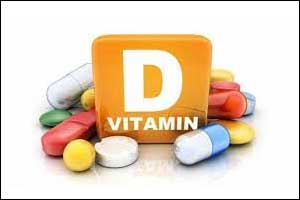- Home
- Editorial
- News
- Practice Guidelines
- Anesthesiology Guidelines
- Cancer Guidelines
- Cardiac Sciences Guidelines
- Critical Care Guidelines
- Dentistry Guidelines
- Dermatology Guidelines
- Diabetes and Endo Guidelines
- Diagnostics Guidelines
- ENT Guidelines
- Featured Practice Guidelines
- Gastroenterology Guidelines
- Geriatrics Guidelines
- Medicine Guidelines
- Nephrology Guidelines
- Neurosciences Guidelines
- Obs and Gynae Guidelines
- Ophthalmology Guidelines
- Orthopaedics Guidelines
- Paediatrics Guidelines
- Psychiatry Guidelines
- Pulmonology Guidelines
- Radiology Guidelines
- Surgery Guidelines
- Urology Guidelines
High-dose vitamin D safe but may not generate better health benefits, finds trial

Vitamin D was discovered about a century ago. Vitamin D supplementation (as cod liver oil, ergocalciferol or cholecalciferol) was rapidly implemented by health authorities and physicians as to eradicate endemic nutritional rickets, at least in high-income countries. How high a dose of Vitamin D can be given safely is not clear.
Researchers conducting Calgary Vitamin D randomized controlled trial have found that Vitamin D supplementation in doses up to 10,000 IU/day appears to be safe and well-tolerated, though higher doses increase the risk of hypercalciuria and mild hypercalcemia.
"Supplementation with vitamin D 4,000 IU/day or more is not necessary for most community-dwelling adults who do not have established vitamin D deficiency," Dr Emma O. Billington of Cumming School of Medicine, University of Calgary, in Canada, told Reuters Health by email. "In individuals who do take 4,000 IU/day or more, medical oversight may be necessary."
Please also read-High vitamin D blood levels may prevent depression in elderly patients
The Calgary Vitamin D Study examined the skeletal effects and safety of oral vitamin D3 (cholecalciferol) supplementation with 400, 4,000, or 10,000 IU/day in 373 healthy adults. There were no bone-strength benefits and a small dose-dependent decrease in bone density, as well as more frequent episodes of mild hypercalcemia and hypercalciuria, with doses of 4,000 or 10,000 IU/day.
In the current report, Dr Billington's team present the complete prespecified safety outcomes from this study.
The peak mean 25-hydroxyvitamin D concentration achieved in the study's 10,000-IU/day group was 198 nmol/L, and no participants discontinued the study treatment based on elevated vitamin D concentration.
Please also read-High vitamin D levels linked to lower cholesterol in children
The three treatment groups did not differ throughout the study in terms of serum calcium or creatinine concentrations or 24-hour urinary calcium excretion, but hypercalcemia and hypercalciuria were significantly more common with higher doses.
There were 16 episodes of mild hypercalcemia in 15 participants, which resolved on follow-up testing in all cases (10 of these cases also reduced calcium intake). Twelve of these events occurred in the 10,000-IU/day group, and four in the 4,000-IU/day group.
Only two participants in the 10,000 IU/day group withdrew from the study based on hypercalcemia (one of these was suspected to have primary hyperparathyroidism).
Hypercalciuria was much more common, occurring at least once in 16.9% of those on 400 IU/day, 22.4% of those on 4,000 IU/day and 30.6% of those on 10,000 IU/day, the researchers report in The Journal of Clinical Endocrinology & Metabolism.
Moreover, 4.0% of 400 IU/day participants, 6.4% of 4,000 IU/day participants and 11.3% of 10,000 IU/day participants had recurrent episodes of elevated 24-hour urine calcium excretion. No participants, however, discontinued the study treatment due to hypercalciuria.
The rates of serious adverse events fall, fractures, skin cancer, and infections did not differ significantly between the groups.
"Physicians may wish to check a 24-hour urinary calcium excretion and a serum calcium level within the first year of treatment, with a plan to reduce calcium intake or lower the vitamin D dose if hypercalciuria or hypercalcemia are detected," Dr Billington said.
Co-author Dr David A. Hanley told Reuters Health by email, "We should not lose sight of the importance of recognizing and treating or preventing vitamin D deficiency. There is a growing consensus that measurable skeletal and non-skeletal benefits of vitamin D supplementation are mainly seen in the setting of vitamin D deficiency. Once a threshold of adequate vitamin D exposure is reached, further benefits appear unlikely to be of major clinical importance."
Dr Alan Gaby, author of Nutritional Medicine and a former professor of nutrition at Bastyr University, in Kenmore, Washington, told Reuters Health by email, "Previous research has shown either a nonsignificant trend toward greater reductions in bone mineral density (BMD) with high-dose vitamin D (as compared with moderate doses) or no difference between high doses and moderate doses."
In the Calgary Vitamin D Study, "bone loss was greater with the higher doses," he said, and "there were trends toward more hypercalciuria, hypercalcemia, falls, and kidney stones in the high-dose groups."
"I think the most important finding is the greater loss of bone," said Dr Gaby, who was not involved in the new work.
vitamin D supplements in doses, several-fold higher than the daily recommended dose for adults (600- 800 IU/d, according to IOM or many other international guidelines, have not proven to generate better general health benefits than smaller doses, at least in “intention to treat analysis”. A daily intake of 3000 IU of vitamin D seem to be safe for most subjects. A daily intake of 4000 IU/d (or higher) can cause modest hypercalcemia or hypercalciuria in a minority of subjects so that regular monitoring is needed.
For further reference log on to :
https://doi.org/10.1210/clinem/dgz282

Disclaimer: This site is primarily intended for healthcare professionals. Any content/information on this website does not replace the advice of medical and/or health professionals and should not be construed as medical/diagnostic advice/endorsement or prescription. Use of this site is subject to our terms of use, privacy policy, advertisement policy. © 2020 Minerva Medical Treatment Pvt Ltd